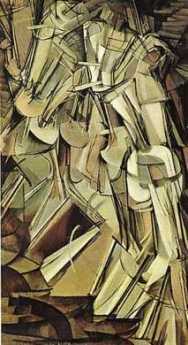Related Topics
Art in Philadelphia
The history of art, particularly painting and sculpture, has been a long and distinguished one. If you add in the art schools, the Philadelphia national influence on artists has been a dominant one.
Modernism and Postmodernism

|
| Modernism |
Artists, musicians, authors and other participants in the cultural world are constantly seeking to innovate. Their eras, movements and other broad trends are mostly defined in retrospect. Quite unlike a scientific subject like radiation oncology or quantum mechanics, the boundaries of cultural movements are fuzzy, the definitions blurred. We think we know what Modernism means, because by common agreement it's over. What Postmodernism means is far less clear, because that's what we think we are having, at present. One eminent scholar of these things was recently driven to give up on Postmodernism; for him, it was just intellectually half-baked.
Modernism seems to define the cultural turmoil provoked by the Industrial Revolution for most of a century, 1880 to 1950. It's distinctive, perhaps defining, characteristic was a constant search for novelty. Why did Modernism come to an end in 1950? Well, because that's when Postmodernism began. The Industrial Revolution didn't stop in 1950, so although it may have provoked Modernism in art and culture, it wasn't enough to sustain it.
Our grandchildren will have to tell the world the final definition of Postmodernism, but at the moment it is thought to represent an artistic tendency to blur the real and the unreal. Some have suggested it was provoked by the Information Revolution, but that came two decades later. A social and economic upheaval with better timing is the rise of the American Century. After Europe committed suicide in World War II, only America was left standing. The thought processes of the Austrian school of Economics, led by von Mises and Hayek, relocated to the University of Chicago, triggering a long string of Nobel Prizes in Economics. Application of mathematics and measurement relentlessly demonstrated that previously undisputed doctrines of Marx, Keynes and other heroes of the left -- were probably just plain wrong. The new Holy Grail was a rising tide raising all the boats. Don't argue with the tape. Marxism is now a discredited response to the industrial revolution, but the art world is equally mistrustful of supply-side economics and other murky mysteries. Certitude is gone; how do we return to the light?
It isn't easy to discard the beliefs of a lifetime. When you do, it affects the way you think about a lot of other things. And it takes a long time for equations and mathematical models of economics to reach out to the world of the liberal arts. For lack of a better explanation for Postmodernism, I suggest that at least the timing of this explanation seems about right.
Originally published: Monday, June 19, 2006; most-recently modified: Friday, May 24, 2019